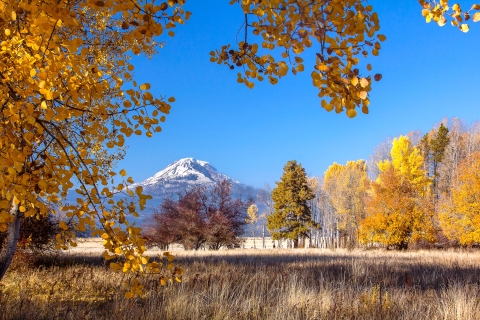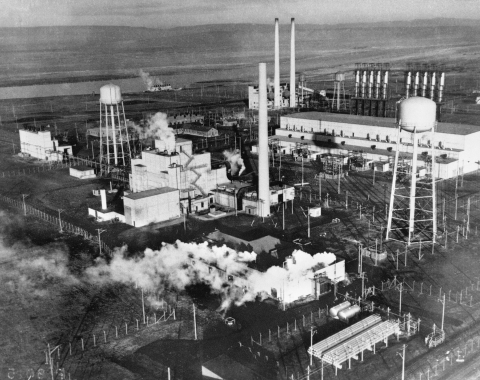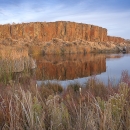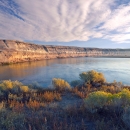Visit Us
Spread across the Yakima Valley, Toppenish National Wildlife Refuge offers a broad collection of habitats, and thus species. Natural and managed wetlands, mixed with shrub-steppe and streams, provide homes for just about every species found in the Columbia Basin. The wildlife, in turn, attracts visitors, mainly hunters and bird watchers. The refuge is well-known for its waterfowl hunting opportunities, and those same waterfowl, along with scores of species of waterbirds, shorebirds and passerines, draw in serious "birders."
The refuge consists of 1,978 acres spread over a distance of 27 miles in the agriculturally intensive Yakima Valley. The main part of the refuge (Robbins and Pumphouse Units) is at the center, with the remaining smaller parcels spread around the valley. Eight of the outlying units lie upstream of the main refuge area, and four are located downstream. The entire refuge is situated within the floodplain of Toppenish Creek, a year-round tributary of the Yakima River.
Toppenish is a refuge of water, so plan your visit accordingly. Even in summer, plan on getting your feet wet.
The refuge is open from sunrise to sunset, except for hunting, which has special hours from 1-1/2 hours before legal hunting time to 1-1/2 hours after. The Toppenish Refuge Headquarters is periodically staffed in the early morning and late afternoon hours.
The main refuge entrance is located six miles south of Toppenish on U.S. Highway 97, then one mile west from the refuge sign. Parking is allowed in designated parking areas only.
Opportunities for recreation at Toppenish National Wildlife Refuge include wildlife observation, hiking and hunting. Wildlife observation and hiking are allowed year-round in the southeast portion of the main refuge from Highway 97 to the Refuge Headquarters. Sport hunting is permitted on the refuge in accordance with state and federal regulations. Hunters should consult the Washington State hunting regulations. Special refuge regulations also apply (see the Rules & Regulations page). Fishing, camping, boating and driving off-road are prohibited on the refuge.
Most areas of the refuge are very remote with no restroom or drinking water facilities; refuge visitors should plan their trips accordingly. Access difficulty varies by area.
For local lodging information, please contact the Toppenish Chamber of Commerce at 509-865-3262.
Activities
Visitor activities on Toppenish National Wildlife Refuge are limited—in number, not in quality. Toppenish doesn't provide a lot of activities, but what it does provide, it does it right.
Other Facilities in the Complex
The four refuges that make up the Central Washington National Wildlife Refuge Complex have little in common, other than being in the state of Washington. That makes the Complex a wonderfully diverse blend of habitats, species, and recreational opportunities. There’s something to be found by everyone that will pique their interest or pull them into the landscape. A geology buff? Visit Columbia National Wildlife Refuge, carved by the great floods of the last ice age. Need a scenic landscape to paint or simply unwind in? Conboy Lake is the spot. Interested in our history? The Hanford Reach National Monument is the place to investigate. Want to add to your birding life list? Check the spring and fall migrations through Toppenish.
Columbia National Wildlife Refuge
Columbia National Wildlife Refuge is a scenic mixture of rugged cliffs, canyons, lakes, grasslands, and sagebrush sagebrush
The western United States’ sagebrush country encompasses over 175 million acres of public and private lands. The sagebrush landscape provides many benefits to our rural economies and communities, and it serves as crucial habitat for a diversity of wildlife, including the iconic greater sage-grouse and over 350 other species.
Learn more about sagebrush . The mix of lakes, carved by unimaginable floods during the last ice age, and surrounding irrigated croplands, a result Grand Coulee Dam and the Columbia Basin Irrigation Project, combined with generally mild winters and the protection provided by the refuge, attracts large numbers of migrating and wintering mallards, Canada geese, tundra swans, and other waterfowl. As winter turns to spring and frozen lakes begin to thaw, additional waterfowl return in great numbers. The largest concentrations of ducks, geese, and lesser Sandhill cranes arrive on the refuge in March and April, at times numbering over 75,000 individuals. The arrival of the cranes and other waterfowl draw visitors from all over the region, centering around the annual Othello Sandhill Crane Festival.
Conboy Lake National Wildlife Refuge
Nestled near the foot of snow-capped Mount Adams in Washington’s Cascade Range, Conboy Lake National Wildlife Refuge is a scenic gem within the National Wildlife Refuge System. The refuge encompasses 6,574 acres of lush seasonal marshes and vibrant forested uplands that beckon to both visitors and wildlife. A blend of wetlands; grassy prairies; streams; and oak, pine, and aspen forests supports a diverse wildlife community. The rich habitat sustains thriving populations of migrating waterfowl and songbirds. The rare Oregon spotted frog breeds in wetlands throughout the refuge. Elk are plentiful and frequently seen along refuge roads. Conboy Lake also supports most of the breeding population of greater Sandhill cranes in Washington. As a national wildlife refuge national wildlife refuge
A national wildlife refuge is typically a contiguous area of land and water managed by the U.S. Fish and Wildlife Service for the conservation and, where appropriate, restoration of fish, wildlife and plant resources and their habitats for the benefit of present and future generations of Americans.
Learn more about national wildlife refuge , this living system will satisfy your longing for splendor and serenity, just as it did for the indigenous peoples, explorers, loggers, and ranchers who were first drawn to the valley’s plentiful resources.
Hanford Reach National Monument
Thousands of acres of land along the Hanford Reach of the Columbia River and the Saddle Mountain National Wildlife Refuge became the Hanford Reach National Monument in 2000 to protect rare plants, wildlife, and remnants of human history. The 196,000-acre Monument is open, treeless country punctuated by steep rolling hills and canyons. Since 1943, what are now Monument lands have been a safe haven for important and increasingly scarce natural and cultural resources. The lands were allowed to remain wild because they served as a security buffer for the top-secret Manhattan Project during World War II, which produced plutonium for atomic weapons. With limited development and grazing, native plants and animals thrived, and a diverse archaeological record has been preserved. The Monument supports 725 vascular plant species—at least 47 of which are species of conservation concern—42 species of mammals, more than 200 species of birds, 9 reptile and 4 amphibian species, 45 species of fish, and over 1,600 species of insects.
Rules and Policies
Unmanned Aircraft & Drones
- The use of unmanned aircraft or drones on the refuge is prohibited.
Night Time Use
- There is no camping, overnight parking, or any other night time use allowed, with the exception of early/late access for hunting.
Fishing
- There is no fishing allowed on Toppenish.
Trapping
- No trapping of any kind is allowed on Toppenish NWR.
Access
- The refuge is open for day use only for all activities, except hunting, sunrise to sunset; no overnight parking or camping is allowed.
- Hunters are allowed access from 1-1/2 hours before legal hunting time to 1-1/2 hours after legal hunting time.
Parking
- Parking is allowed in designated parking areas only.
Other Prohibited Activities
- Other prohibitions on the refuge are dogs off-leash; off-road vehicles; and collecting of plants, animals, minerals, antlers, and artifacts.
Hunting
- Waterfowl (duck, goose and coot), snipe and upland gamebird hunting are permitted on the refuge during the regular Washington State hunting seasons in public hunting areas designated on the refuge map.
- All other species are protected, e.g., coyotes, cougars, crows, deer, squirrels, turkeys, and rabbits.
- For the current regulations related to hunting on Toppenish NWR, please visit www.fws.gov/mcriver/regulations/.
Firearms
- Firearms and other weapons are subject to state law. At all times, persons possessing, transporting, or carrying firearms on the refuge must comply with all provisions of state law.
- Firearms may only be discharged in accordance with refuge hunting regulations, i.e., only during the lawful pursuit of game during legal seasons.
- Only shotguns are permitted for hunting and only with non-toxic shot.









